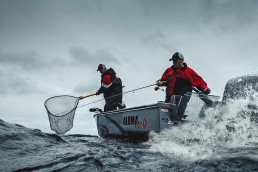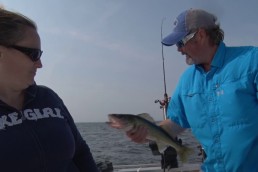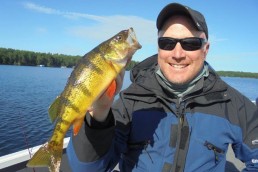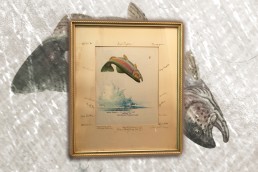Is Back-trolling a Lost Art?
SHARE THIS POST
The deadly tactic of back-trolling earned its stripes in the early 1960s when walleye anglers learned from fishing pioneers like Al and Ron Lindner, Spence Petros, Carl Malz and regular contributors to Fishing Facts. It was an era when anglers were creating and perfecting the techniques of fishing nightcrawlers and leeches with tools like bottom bouncers and the then newly invented Lindy Rig.
The challenge was to troll slow enough to keep those baited rigs in contact with bottom structure or nearly touching weedlines that followed highly irregular shapes—a favorite haunt of walleyes. Trolling forward in a 16-foot V-bottom aluminum boat, even with a 10-hp motor, was too fast for these light rigs. However, if an angler put the motor in reverse and trolled backward, the blunt face of the transom slowed the boat enough for an effective presentation.
Back-trolling seemed a perfect solution until it was necessary to troll into the wind, which caused waves to break over the transom, filling a boat with water. Of course, this was before bailers were popular, as these were low-tech aluminum fishing boats. Anglers found it difficult to hold a rod, steer the motor backward and use a bucket to bail water out of the boat. But walleye anglers, being a creative bunch, soon fashioned transom-mounted splashguards to keep out the water. Soon in those days there were almost as many articles on how to make your own guards as there were on back-trolling. Some were made of aluminum, Plexiglas and thick sheets of rubber. Then some were bolted on while some were clamped to the transom.
“Now, we even put backsplash guards on our bass boats to keep waves from washing over the transom when we must use a launch ramp that faces the wind,” Al Lindner said.
Today, anglers and writers don’t mention the back-trolling tactic as often. But according to Lindner, it is still “the absolute, most precise way to keep a lure on structure and in the strike zone.”
Still wondering about the popularity of back-trolling today, we contacted professional guide Tony Roach. According to him, back-trolling is alive and well, even graduating to big-water boats in the 18- to 20-foot range.
“I have a 20-foot Lund Pro-V with a 200-hp tiller-steering motor,” Roach said. “With the SmartCraft feature, I can run the motor as low as 500 RPMs, which is fine for trolling at 1 to 1.5 mph.”
His engine has a standard shaft length, but he runs a four-blade prop instead of a three-blade model, believing it moves a more appropriate amount of water. Roach has two Minn Kota trolling motors. The bow-mount unit can self-deploy with a remote control while the transom-mounted unit has tiller steering.
Are you enjoying this post?
You can be among the first to get the latest info on where to go, what to use and how to use it!
Even with today’s battery- and trolling-motor technology, wind and waves can be too much for the strongest 36-volt motors to keep a boat on structure for very long.
So why is back-trolling so effective?
“The bow swings too much for precision trolling forward,” Roach says.
He also says the flat part of the transom allows an angler much more boat control.
“It also allows you to hold yourself better in the current (for river fishing).”
Even salmon anglers who fish rivers have created their version of back-trolling while using the tactic to slip downstream and bounce crankbaits off the bottom. However, they point the boat upstream and row just fast enough to let the boat slowly slide downstream.
Conventional back-trollers are in luck—they no longer have to design and build their own backsplash guards. There are at least two manufacturers who build backsplash units specifically for your chosen boat and model including Wave-Wackers and Whitecap Splashguard. Stock models are available from Ve-Ve Incorporated.
While back-trolling may not be an all-encompassing panacea, it is alive and well. However, it has been kept in the background for a reason.
MWO
SHARE THIS POST
Did you enjoy this post?
You can be among the first to get the latest info on where to go, what to use and how to use it!
Darrell Taylor
Darrell Taylor has fished for more than 65 years. During the past 25 years, Taylor has generated more than 2,000 published articles, columns and fishing reports. His writings received 14 peer-level awards from outdoor writer organizations, including the Association of Great Lakes Outdoor Writers “Excellence in Craft” Golden Glow Award, their highest recognition.



